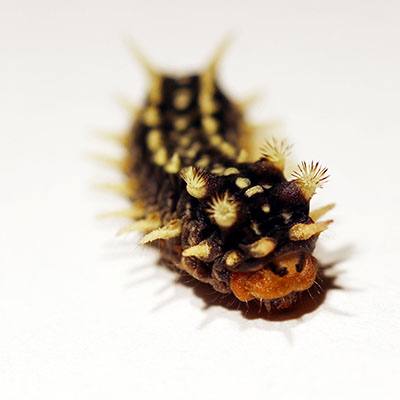The venom of a caterpillar, native to South East Queensland, shows promise for use in medicines and pest control, Institute for Molecular Bioscience researchers say.
The Doratifera vulnerans is common to large parts of Queensland’s south-east and is routinely found in Toohey Forest Park on Brisbane’s southside.
Dr Andrew Walker has been researching the striking looking caterpillar since 2017.
Venomous caterpillar has strange biology
“We found one while collecting assassin bugs near Toowoomba and its strange biology and pain-causing venom fascinated me,” Dr Walker said.
Unlike The Very Hungry Caterpillar that charmed generations of children around the world, this caterpillar is far from harmless.
“Its binomial name means ‘bearer of gifts of wounds’,” Dr Walker said.
Caterpillar venom similar to spiders

Dr Walker’s research found the caterpillar has venom toxins with a molecular structure similar to those produced by spiders, wasps, bees and ants.
The research also unlocked a source of bioactive peptides that may have uses in medicine, biotechnology or as scientific tools.
“Many caterpillars produce pain-inducing venoms and have evolved biological defences such as irritative hairs, toxins that render them poisonous to eat, spots that mimic snake eyes or spines that inject liquid venoms,” Dr Walker said.
“Previously researchers had no idea what was in the venom or how they induce pain.
Venom with stunning complexity
“We found that the venom is mostly peptides and shows stunning complexity, containing 151 different protein-based toxins from 59 different families.”
The researcher team synthesised 13 of the peptide toxins and used them to show the unique evolutionary trajectory the caterpillar followed to produce pain-inducing venom.
“We now know the amino acid sequences, or the blueprints, of each protein-based toxin,” Dr Walker said.
“This will enable us to make the toxins and test them in diverse ways.”

Venom which can kill bacteria
Some peptides already produced in the laboratory as part of Dr Walker’s research showed very high potency, with potential to efficiently kill nematode parasites that are harmful to livestock, as well as disease-causing pathogens.
“Our research unlocks a new source of bioactive peptides that may have use in medicine, through an ability to influence biological processes and promote good health,” he said.
Potential for medicines and pesticides
“First, we need to work out what the individual toxins do, to inform us about how they might be used.”
The findings incorporate work from researchers at the CSIRO, Canada’s York University, Austria’s University of Vienna and the Department of Food and Agriculture in the US.
The research is published in the Proceedings of the National Academy of Sciences of the USA.

